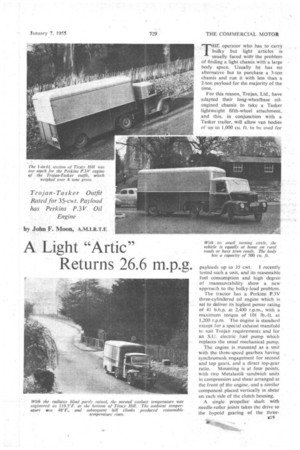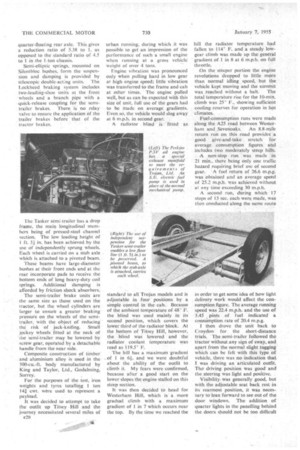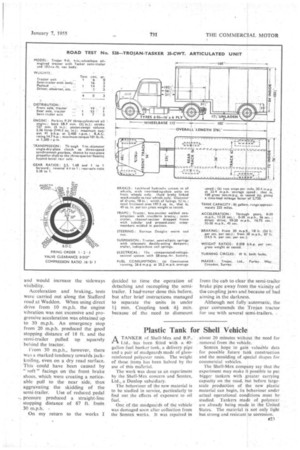A Light "Artie" Returns 26.6 m.p.g.
Page 59

Page 60

Page 63

If you've noticed an error in this article please click here to report it so we can fix it.
by John F. Moon, A.M.I.R.T.E
Trojan-Tasker Outfit Rated for 35-mt. Payload has Perkins P.3V Oil Engine
HE operator who has to carry bulky but light articles is usually faced withthe problem of finding a light chassis with a large body space. Usually he has no alternative but to purchase a 3-ton chassis and run it with less than a 2-ton payload for the majority of the time.
For this reason, Trojan, Ltd., have adapted their long-wheelbase oilengined chassis to take a Tasker lightweight fifth-wheel attachment, and this, in conjunction with a Tasker trailer, will allow van bodies of up to 1,000 Cuft. to he used for payloads up to 35 ewt. I recently tested such a unit, and its reasonable fuel consumption and high degree of manteuvrability show a new approach to the bulky-load problem.
The tractor has a Perkins P.3V three-cylindered oil .engine which is set to deliver. its highest power rating of 41 b.h.p. at 2,400 r.p.m., with a maximum torque of 101 1b-ft. at 1,200 r.p.m. The engirie, is standard except for a special exhaust manifold to suit Trojan requirements and for an SIT. electric fuelpump which replaces the usual mechanical pump.
The engine is mounted as a unit with the three-speed gearbox having synchromesh engagement for second and top gears, and a direct top-gear ratio. Mounting is at four points; with two fvletalastik sandwich units in compression and shear arranged at the front of the engine, and a similar component placed vertically in shear on each side of the clutch housing.
• A single propeller shaft with needle-roller joints takes the drive to the hypoid gearing of the three
quarter-floating rear axle. This gives a reduction ratio of 5.38 to 1, as opposed to the standard ratio of 4.5 to I in the 1-ton chassis.
Semi-elliptic springs, mounted on Silentbloc bushes, form the suspension and damping is provided by
telescopic double-acting units. The Lockheed, braking system includes two-leading-shoe units at the front wheels and a branch Pipe with a quick-release coupling for the semi
trailer brakes. There is no relay valve to ensure the application of the trailer brakes before that• of the tractor brakes.
The Tasker semi-trailer has a drop frame, the main longitudinal members being of pressed-steel channel section. The low loading height of 1 ft. 54 in. has been achieved by the use of independently sprung wheels. Each wheel is carried on a stub axle which is attached to a pivoted beam.
These beams have large-diameter hushes at their front ends and at the rear incorporate pads to receive the bottom ends of long heavy-duty coil springs. Additional damping is afforded by friction shock absorbers.
The semi-trailer brake units are the same size as those used on the tractor, but the wheel cylinders are larger to ensure a greater braking pressure on the wheels of the semitrailer, with the object of reducing
. the risk Of jack-knifing. Small jockey wheels fitted at the neck of lie semi-trailer may be lowered by screw gear, operated by a detachable handle from the near side.
Composite construction of timber and aluminium alloy is used in the 500,cu.-ft. body manufactured by King and Taylor, Ltd., Godalrning, Surrey.
For the purposes of the test, iron weights and tyres totalling 1 ton IQ. cwt. were used to represent a payload.
It was decided to attempt to take the outfit up Titsey Hill and the journey necessitated several miles of c20 urban running, during which it was possible to get an impression of the performance of such a small engine when running at a gross vehicle' weight of over 4 tons.
Engine vibration was pronounced only when pulling hard in low gear at high engine speed; little vibration was transferred to the frame and cab at other times. The engine pulled well, but as can be expected with this size of unit, full use of the gears had to be made on average gradients. Even so, the vehicle would slog away at 6 m.p.h. in second gear.
A radiator blind is fitted as standard to all Trojan models and is adjustable in four positions by a
simple control in the cab. Because of the ambient temperature of 480 F.
the blind was used mainly in its second position, which covers the lower third of the radiator block. At the bottom of Titsey Hill, however, the blind was lowered and the
radiator coolant temperature was read as 119.5° F.
The hill has a maximum gradient of 1 in 61,, and we were doubtful about the ability of the outfit to climb it. My fears were confirmed, because after a good Start on the lower slopes the engine stalled on this steep section.
It was then decided to head for Westerham Hill, which is a more gradual climb with a maximum gradient of 1 in 7 which occurs near the top. By the time we reached the
hill the radiator temperature had fallen to 114° F. and a steady lowgear climb was made up the general gradient of 1 in 8 at 6 m.p.h. on full throttle.
On the steeper portion the engine revolutions dropped to little more than normal idling, speed, but the vehicle kept moving and the summit was reached without a halt. The total temperature rise for the 10-min. climb was 25' F., showing sufficient cooling reserves for operation in not climates..
Fuel-consumption runs were made along the A25 road between Westerham and Sevenoaks. An 8.8-mile return run on this road provides a good give-and-take stretch for average consumption figures and includes two moderately steep hills.
A non-stop run was made in 21 min., there being only one traffic hazard requiring brief use of second gear. 'A fuel return of 26.6 m.p.g. was obtained and an average speed of 25.2 m.p.h. was achieved without at any time exceeding 30 m.p.h.
A second run, during which 17 stops of IS sec. each were made, was then conducted along the same route in order to get some idea of how light delivery work would affect the consumption figure. The average running speed was 22.4 m.p,h. and the use of 3,45 pints of fuel indicated a consumption rate of 20.4 m.p.g.
I then drove the unit back to Croydon for the short-distance trials. The semi-trailer followed the tractor without any sign of sway, and apart from the normal slight tugging which can be felt with this type of vehicle, there was no indication that I was driving an articulated outfit. The driving position was good and the steering was light and positive.
Visibility, was generally good, but with the adjustable seat back rest in its rearmost position, it was necessary to-lean forward to see out of the door windows. The addition of quarter lights in the panelling behind the doors should not be too difficult
and would increase the sideways visibility.
Acceleration and braking_ tests were carried out along the Stafford road at Waddon. When using direct drive from 10 m.p.h. the engine vibration was not excessive and progressive acceleration was obtained up to 30 m.p.h. An emergency stop from 20 m.p.h. produced the good stopping distance of 18 ft. and the semi-trailer pulled up squarely behind the tractor.
From 30 m.p.h., however, there was a marked tendency towaids jackknifing, even on a dry road surface. This could have been caused by " soft" facings on the front brake shoes, which were creating a noticeable pull to the near side, thus aggravating the skidding of the semi-trailer. Use of reduced pedal — pressure produced a straight-line stopping distance of 67 ft. from 30 m.p.h.
On my return to the works I decided to time the operation of detaching and recoupling the semitrailer. I had-never done this before, but after brief instructions managed to separate the units in under min. Coupling took 4 min. because of the need to dismount from the cab to clear the semi-trailer brake pipe away from the vicinity of the coupling jaws and because of bad aiming in the darkness.
Although not fully automatic, the gear commends the Trojan tractor for use with several semi-trailers. .
















































































































